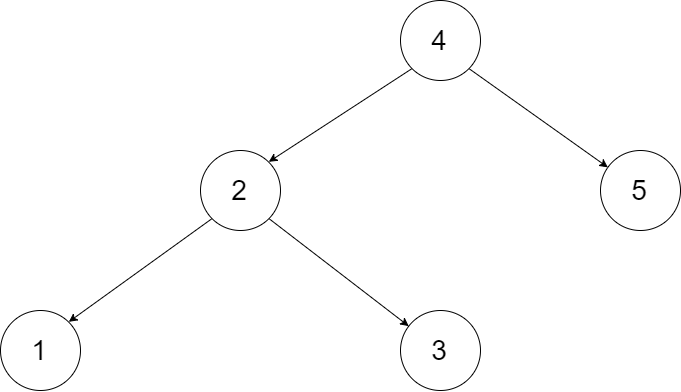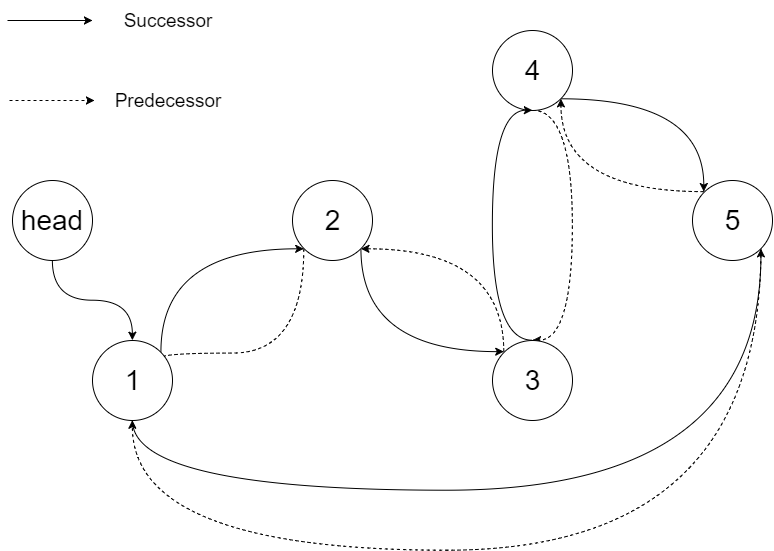Convert a Binary Search Tree to a sorted Circular Doubly-Linked List in place.
You can think of the left and right pointers as synonymous to the predecessor and successor pointers in a doubly-linked list. For a circular doubly linked list, the predecessor of the first element is the last element, and the successor of the last element is the first element.
We want to do the transformation in place. After the transformation, the left pointer of the tree node should point to its predecessor, and the right pointer should point to its successor. You should return the pointer to the smallest element of the linked list.
Example 1:

Input: root = [4,2,5,1,3]Output: [1,2,3,4,5] Explanation: The figure below shows the transformed BST. The solid line indicates the successor relationship, while the dashed line means the predecessor relationship.

Example 2:
Input: root = [2,1,3] Output: [1,2,3]
Example 3:
Input: root = [] Output: [] Explanation: Input is an empty tree. Output is also an empty Linked List.
Example 4:
Input: root = [1] Output: [1]
Constraints:
-1000 <= Node.val <= 1000Node.left.val < Node.val < Node.right.val- All values of
Node.valare unique. 0 <= Number of Nodes <= 2000
/*
// Definition for a Node.
class Node {
public:
int val;
Node* left;
Node* right;
Node() {}
Node(int _val) {
val = _val;
left = NULL;
right = NULL;
}
Node(int _val, Node* _left, Node* _right) {
val = _val;
left = _left;
right = _right;
}
};
*/
class Solution {
public:
Node* treeToDoublyList(Node* root) {
if (root == NULL) {
return root;
}
Node *head = NULL, *tail = NULL;
helper(root, head, tail);
head -> left = tail;
tail -> right = head;
return head;
}
void helper(Node* root, Node* &head, Node* &tail) {
if (root == NULL) {
return;
}
helper(root -> left, head, tail);
if (head == NULL) {
head = root;
} else {
tail -> right = root;
root -> left = tail;
}
tail = root;
helper(root -> right, head, tail);
}
};
======= Iterative ====
void iterative_helper(TreeNode* root, TreeNode *&head, TreeNode *&tail) {
if (root == NULL) {
return;
}
stack<TreeNode*> st;
TreeNode* node = root;
while(node != NULL || !st.empty()) {
while (node != NULL) {
st.push(node);
node = node -> left;
}
TreeNode* poped_node = st.top(); st.pop();
if (head == NULL) {
head = poped_node;
tail = poped_node;
} else {
tail -> right = poped_node;
poped_node -> left = tail;
tail = poped_node;
}
node = poped_node -> right;
}
head -> left = tail;
tail -> right = head;
}
========================== iterative approach O(log n) space ====== https://www.cnblogs.com/grandyang/p/9615871.html
class Solution { public: Node* treeToDoublyList(Node* root) { if (!root) return NULL; Node *head = NULL, *pre = NULL; stack<Node*> st; while (root || !st.empty()) { while (root) { st.push(root); root = root->left; } root = st.top(); st.pop(); if (!head) head = root; if (pre) { pre->right = root; root->left = pre; } pre = root; root = root->right; } head->left = pre; pre->right = head; return head; } };

No comments:
Post a Comment